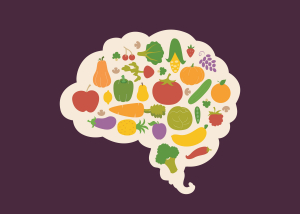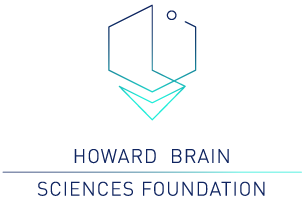For July, the Brain Blog topic will be nutrition. Nutrition “encompasses an extremely broad range of medical, social, commercial, and ethical domains,” and is a core part of our overall health (Lorenzo et al., 2017). Nutrition and diet are also an informative piece of a patient’s history as what one eats are often determined by personal history, access, culture, and religion (Gómez-Pinilla, 2008). Food components “can be classified into nutrients and non-nutrients,” nutrients being classified as micronutrients or macronutrients (Chen, Michalak, Agellon, 2018). Micronutrients include vitamins and minerals and are needed in smaller amounts than macronutrients, “which include carbohydrates, proteins, and fats, are typically needed in large” quantities (Chen, Michalak, Agellon, 2018).
The human brain “consumes an immense amount of energy relative to the rest of the body” (Gómez-Pinilla, 2008). Nutrients cross the blood-brain barrier by coupling with the movement of an ion moving into the brain (Swenson, 2006). The brain fuels itself using glucose but needs other resources such as fat and protein to function and produce cells (Gómez-Pinilla, 2008). For example, omega-3 fatty acids may help prevent depression and dementia and are involved in membrane renewal and maintaining synaptic function (Bourre, 2009; Gómez-Pinilla, 2008). Meanwhile, diets high in saturated fat “are becoming notorious for reducing molecular substrates that support cognitive processing and increasing the risk of neurological dysfunction in humans and animals” (Gómez-Pinilla, 2008).
While nutrients directly entering the brain affect cognition, eating also triggers neurotransmitters via the ventral tegmental area in the midbrain (Volkow, Wang & Baler, 2011). Human ingestion of food has been “shown to release [dopamine] in the dorsal striatum in proportion to the self-reported level of pleasure derived from eating the food” (Volkow, Wang & Baler, 2011). Dopamine “is produced in the substantia nigra, ventral tegmental area, and hypothalamus” and is involved in the processes of reward, memory, and movement regulation in the brain (Juárez Olguín, Calderón Guzmán, Hernández García & Barragán Mejía, 2016). Meanwhile, aversions to taste are formed through “mechanisms of learning and memory that involve the hypothalamus, the hippocampus and the amygdala” (Gómez-Pinilla, 2008).
Balanced and sufficient nutrition has been associated with improved academic performance ranging from juvenile to collegiate performance (Burrows, Whatnall, Patterson & Hutchesson, 2017). Experts propose that this is due to increased micronutrients, such as folate, iron, and omega-3 fatty acids (Burrows et al., 2017). However, other factors that affect academic success also interact with nutritional access, such as socio-economic status (SES), gender, and other health behaviors (Burrows et al., 2017).
Food deserts are “neighborhoods and communities that have limited access to affordable and nutritious foods” (National Research Council, 2009). While food deserts are often associated with cardiovascular disease, there is also an association between food deserts and decreased academic performance (Frndak, 2014).
Just as there are many aspects of health and nutrition, there are many nonprofits devoted to this topic. The Institute for Food and Development Policy, also known as Food First, was founded in 1975 and “envisions a world in which all people have access to healthy, ecologically produced, and culturally appropriate food” (Food First, 2020). Food First has produced academic publications, policy briefs, lectures, and primers, as well as directly engaging with community struggles (Food First, 2020).
Feeding America is also focused on providing proper nutrition and increasing food-security (Feeding America, 2020). Feeding America has also determined that hunger increases children’s likelihood of struggling at school as well as adult’s likelihood of having psychological or behavioral health issues (Feeding America, 2020). Feeding America’s Hunger Blog also identifies children facing hunger as “56.2% more likely to have PTSD and 53.1% more likely to have severe depression” (Waite, 2019).
Lastly, the American Nutrition Association aims to amplify well-researched and personalized nutrition (The American Nutrition Association, 2019). Their work is organized around six core principles, each detailing a different aspect of the complexity of nutrition (The American Nutrition Association, 2019). Their core tenets include that nutrition is personal, a category of both science and medicine, an aspect of healthcare, organized via social ecosystems and should be available to all persons (The American Nutrition Association, 2019).
For more information about the basics of nutrition, you can also read about the history and policy goals of the USDA, review the basics of digestion, and check out our following articles this month.
Written by Senia Hardwick
References
Bourre, J. M. (2009). Diet, brain lipids, and brain functions: Polyunsaturated fatty acids, mainly omega-3 fatty acids. In A. Lajtha, G. Tettamanti, & G. Goracci (Eds.), Handbook of Neurochemistry and Molecular Neurobiology (pp. 409–441). Springer US. https://doi.org/10.1007/978-0-387-30378-9_17
Burrows, T. L., Whatnall, M. C., Patterson, A. J., & Hutchesson, M. J. (2017). Associations between dietary intake and academic achievement in college students: A systematic review. Healthcare, 5(4). https://doi.org/10.3390/healthcare5040060
Chen, Y., Michalak, M., & Agellon, L. B. (2018). Importance of nutrients and nutrient metabolism on human health. The Yale Journal of Biology and Medicine, 91(2), 95–103.
Donini, L. M., Leonardi, F., Rondanelli, M., Banderali, G., Battino, M., Bertoli, E., Bordoni, A., Brighenti, F., Caccialanza, R., Cairella, G., Caretto, A., Cena, H., Gambarara, M., Gentile, M. G., Giovannini, M., Lucchin, L., Migliaccio, P., Nicastro, F., Pasanisi, F., … Muscaritoli, M. (2017). The domains of human nutrition: The importance of nutrition education in academia and medical schools. Frontiers in Nutrition, 4. https://doi.org/10.3389/fnut.2017.00002
Feeding America. (2020). Our work | feeding america. https://www.feedingamerica.org/our-work
Food First. (2020). About us. Food First. https://foodfirst.org/about-us/
Frndak, S. E. (2014). An ecological study of food desert prevalence and 4th grade academic achievement in new york state school districts. Journal of Public Health Research, 3(3). https://doi.org/10.4081/jphr.2014.319
Gómez-Pinilla, F. (2008). Brain foods: The effects of nutrients on brain function. Nature Reviews. Neuroscience, 9(7), 568–578. https://doi.org/10.1038/nrn2421
Juárez Olguín, H., Calderón Guzmán, D., Hernández García, E., & Barragán Mejía, G. (2016). The role of dopamine and its dysfunction as a consequence of oxidative stress. Oxidative Medicine and Cellular Longevity, 2016. https://doi.org/10.1155/2016/9730467
National Institute of Diabetes and Digestive and Kidney Diseases. (2017). Your digestive system & how it works | niddk. National Institute of Diabetes and Digestive and Kidney Diseases. https://www.niddk.nih.gov/health-information/digestive-diseases/digestive-system-how-it-works
National Research Council (US). (2009). Summary. National Academies Press (US). https://www.ncbi.nlm.nih.gov/books/NBK208018/
Swenson. (2006). Chapter 12: The nutrition of the brain. https://www.dartmouth.edu/~rswenson/NeuroSci/chapter_12.html
The American Nutrition Association. (2019). The story of the american nutrition association® | american nutrition association. https://theana.org/OurStory
U.S. Department of Agriculture. (2020). About us | choosemyplate. https://www.choosemyplate.gov/about-us
Volkow, N. D., Wang, G.-J., & Baler, R. D. (2011). Reward, dopamine and the control of food intake: Implications for obesity. Trends in Cognitive Sciences, 15(1), 37–46. https://doi.org/10.1016/j.tics.2010.11.001
Waite, T. (2019). 3 devastating effects of hunger on the body | feeding america. https://www.feedingamerica.org/hunger-blog/3-ways-hunger-affects-your-body
